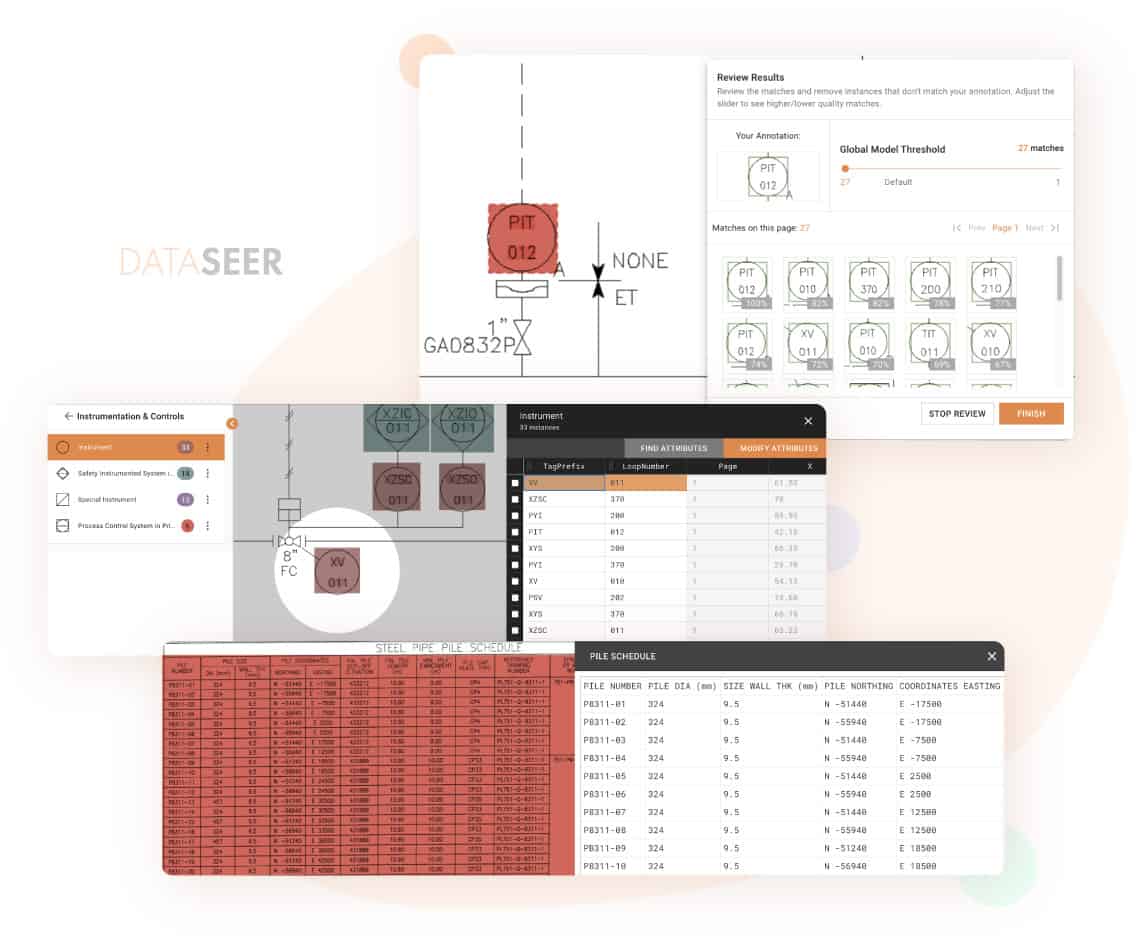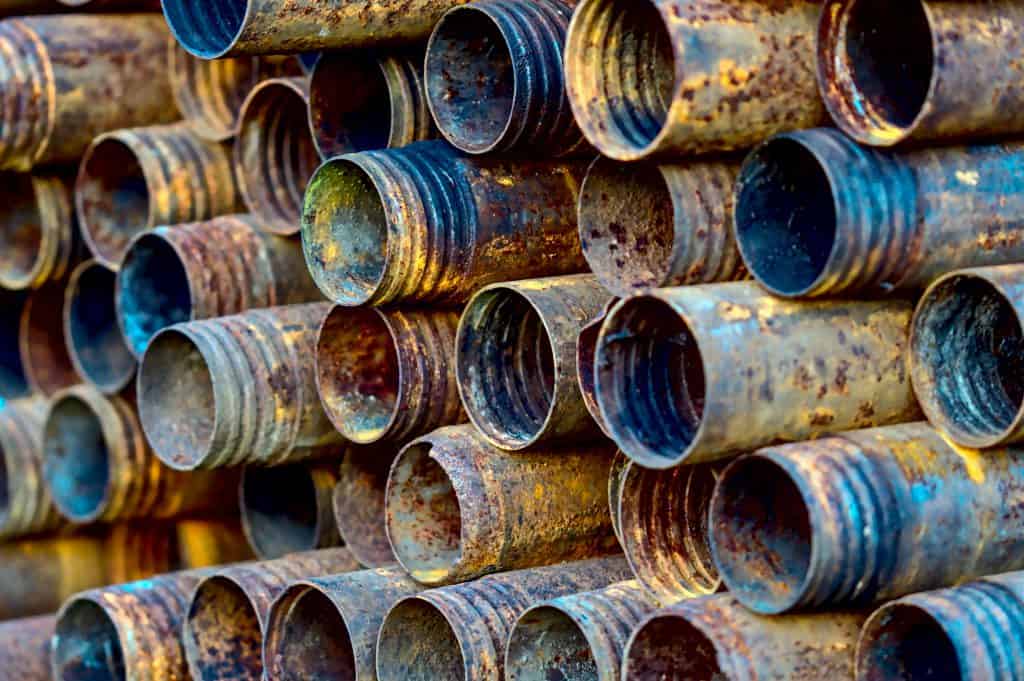Where AI and Industrial Diagrams Meet
11,109 hours saved using DataSeer in 2023 to date.
Take Off Estimation Asset Data Model Extraction Revision Tracking Auto-Detection of Control Loops Auto-Recognition of Symbols Project Collaboration Table Extraction CAD Digitization CSV Data Export
Use AI to automatically extract info from engineering diagrams & datasheets
Analyze and extract the data you need from Diagrams & Datasheets
DataSeer provides automated visualization software that digitizes unstructured data trapped in 2D images and creates a digital twin database with API access.
Integrating industrial engineering with Machine Learning and Computer Vision, DataSeer facilitates rapid project turnaround, automates change management tracking, and reduces risks associated with the integration of legacy and greenfield processes.
Use DataSeer to...
Extract information that can be used across multiple use cases, including Asset Integrity Management, Plant Cybersecurity, Capital Projects Engineering & Estimating, Process Simulations, Plant Operations and Maintenance.
Some use cases:
- Rapidly estimate cost for planning, bidding, fabrication & construction
- Extract tabular data such as equipment lists, bill of materials and datasheets
- Convert legacy diagram images to digitized CAD drawing formats

Transforming the use of Industrial Drawings
We help teams do
their best work.
Leverage an AI-based asset data extraction tool like DataSeer to get unstructured data trapped in disparate industrial 2D flat images out in a high-fidelity digitized format.
Why users love DataSeer
Drive revenue with faster project turnaround & onboarding
Increase ROI by up to 10x
Minimize cost overruns associated with change management
Reduce costs from laborious error-prone manual efforts
Increase quality control with always-on, accurate database of process & asset data
Decrease liability by minimizing risk from errors & omissions
Key Benefits
Off-the-shelf application, no setup or configuration
User-centric design that's easy & intuitive to use
Use our default P&ID symbol library or build your own!

CASE STUDY
An international industrial software company wanted to accelerate the manual extraction of asset models from PDF drawings and fed & integrated into their Operator Training Simulation (OTS) software. This data model setup is a prerequisite to software use and throttles the onboarding of more customers & users.
DataSeer digitizes unstructured data on a 2D flat image to a structured format like CSV for export. API integrations into data pipelines or application also make large-scale data extraction scalable.
Automation of manual data model extraction means higher margins on each customer and more customers onboarded, leading to more sales revenue.
CASE STUDY
A recycling operator wanted to track revisions between PDF drawings during retrofitting of pre-owned process facilities that they purchased. Errors in MTO data make change management challenging and delay the entire retrofitting process.
DataSeer’s revisioning function shows visual differences between drawing versions. Data diffs can also be conducted on exported CSV data snapshots.
With 90+% efficiency gains in work throughput, the operator now has more effective and efficient change management processes in place.
CASE STUDY
An engineering data management solutions provider needed to overlay 2D P&ID data on top of their asset-centric data warehouse to enhance an existing customer solution so their users could get detailed context in an interactive way. Building this additional functionality from scratch in-house required significant investment & time.
DataSeer offered them a way to quickly digitize unstructured data on a 2D image into a structured format like CSV for export out of the tool. Coordinate location data for extracted symbols are also included in the data export, which — when combined with current tools — allowed for the mapping to be altered on top of original drawings.
The software solutions provider was able to increase the breadth & diversity of their data product offerings to users, creating a new revenue source with a reduction in cost and faster turnaround time.
CASE STUDY
An EPC wanted to identify outdated data in the master asset registry since discrepancies between what’s in the field vs in the the database leads to more rework and iteration in inspection and operations & maintenance activities. Data in the data registry does not always get updated to reflect upgrades and maintenance that’s occurred in the field.
DataSeer digitizes unstructured data on a 2D image to a structured format like CSV, allowing for exported data to be imported into a database, data lake or another software platform. The EPC’s global teams were able to collaborate on projects seamlessly, thanks to project collaboration roles available in the tool.
Beyond realizing 60-80% process efficiency gains using the tool, the EPC also was able to conduct more effective & accurate inspection, NDT, maintenance & information management.
CASE STUDY
A large international EPC wanted to improve accuracy and reduce the time its workforce spent working with engineering drawings in order to optimize its cost-estimation process. Improper cost estimation leads to cost overrun, delayed schedules and scope-creep. Low win rates on lump sum project bids may also occur due to contingencies added with uncertain estimates.
Using DataSeer, the estimation team extracted information (counts, attributes, connectivity) about valves, instruments and line numbers from P&ID images in brownfield engineering projects or during bid phases, where CAD source formats are not available. Beyond P&IDs, the team also processed PDFs of mechanical equipment schematics, plot plant layouts, process flow diagrams & electrical single line diagrams.
The tool reduced effort from weeks to a few days, with 85+% efficiency gains typical. This results in not only higher margins from profitable projects but also higher bid win rates.
CASE STUDY
A Canadian engineering services provider had to conduct a risk assessment on piping & equipment as part of an operator’s Risk-Based Inspection (RBI) program in order to understand existing operational health of facilities at the equipment level and piping level.
They extracted operating conditions such as temperature & pressure from fixed equipment and piping line numbers from 109 P&IDs containing 230 equipment and 817 line numbers using DataSeer’s symbol & text extraction and line association functionalities.
Total time taken to extract operating conditions of equipment & piping was reduced by 44% using DataSeer compared to manual data extraction that took 7 hours.





